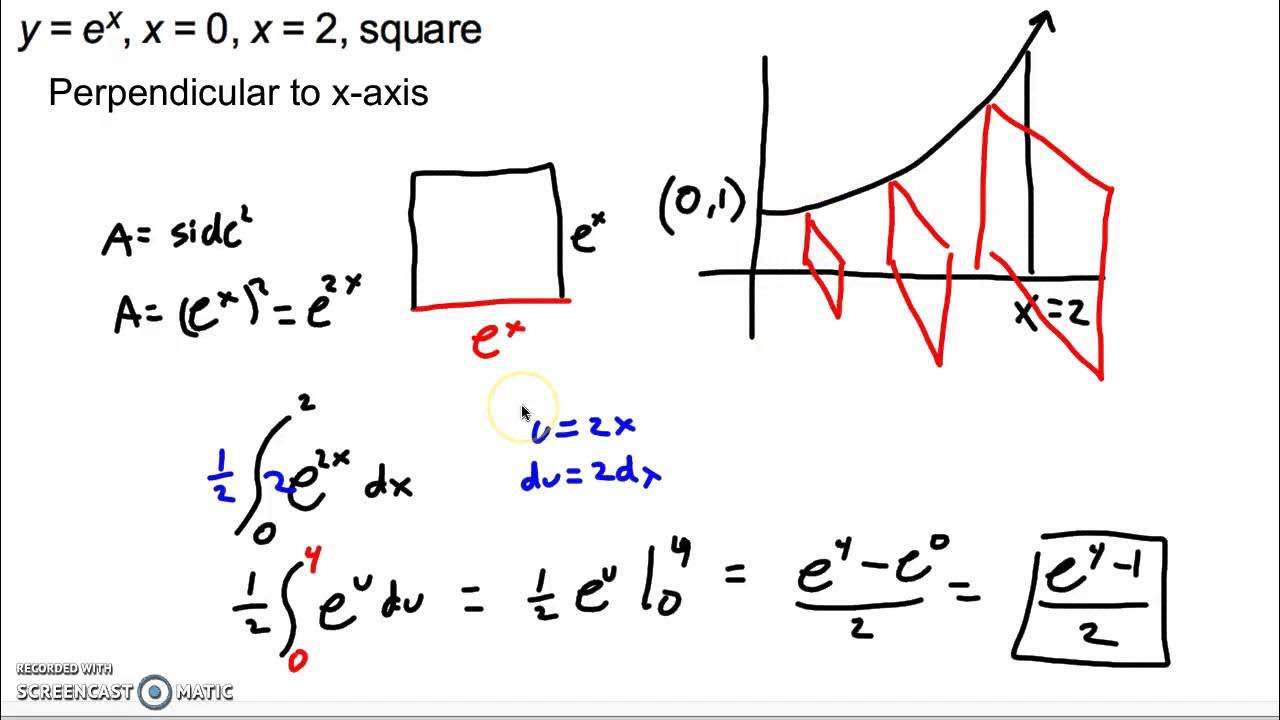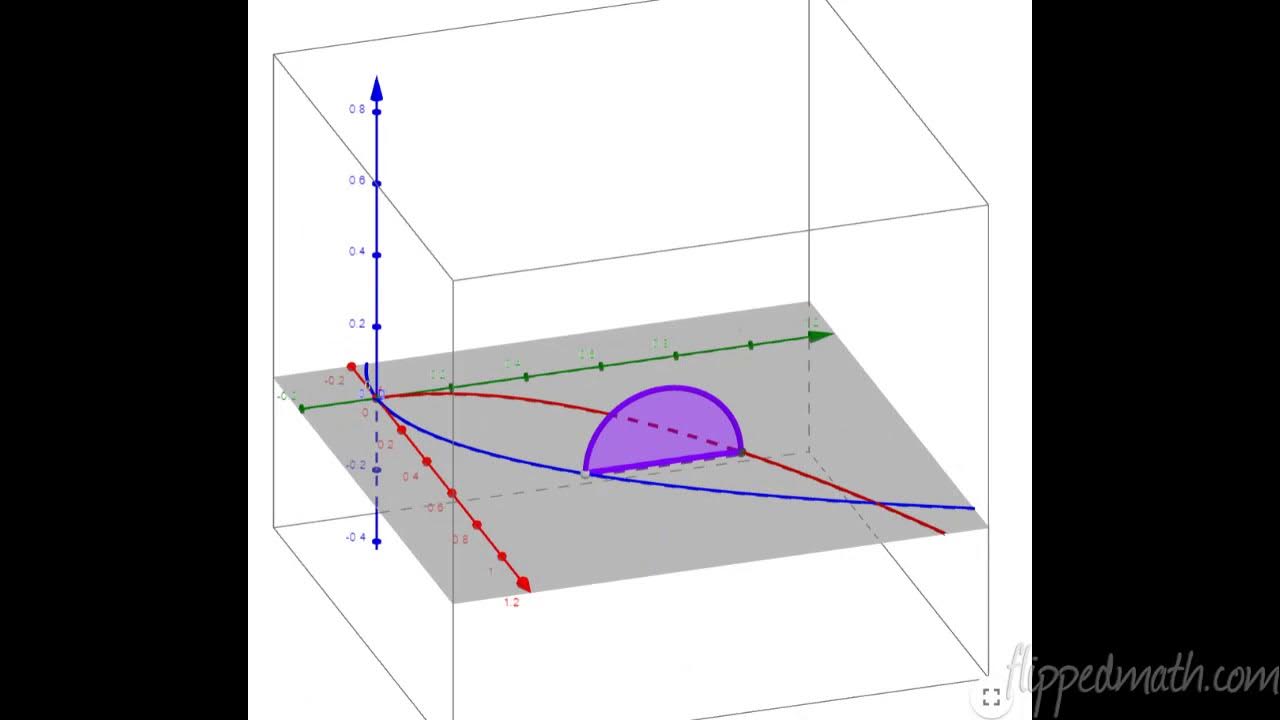Volumes with Known Cross Sections with Calculus, pg 2
TLDRThe video script discusses the concept of calculating the volume of a solid using calculus, specifically through the method of integrating the area of cross-sections. The presenter emphasizes the importance of expressing the area of a cross-section in terms of the variable of integration, be it x or y. Various shapes such as squares, rectangles, equilateral triangles, and semicircles are covered, each with its own formula for area in terms of a segment 's'. The presenter also highlights the need to memorize certain formulas for quick problem-solving. The script provides a step-by-step approach to solving a problem where the base of the solid is a circle and the cross sections are squares, semicircles, and equilateral triangles. The key takeaway is that once the segment 's' is identified and the appropriate formula is applied, the integration process becomes straightforward. The presenter concludes by encouraging viewers to practice drawing the regions and understanding 's' for success in these types of problems.
Takeaways
- 📚 To calculate the volume of a solid with a known cross-sectional shape, integrate the area of the cross-section from the start to the end point.
- 👕 The speaker humorously mentions changing shirts due to the heat, adding a personal touch to the lecture.
- 📐 The area of a cross-section must be expressed in terms of the variable of integration, either x or y, depending on the axis it is perpendicular to.
- 🔍 Memorizing area formulas for common shapes (squares, rectangles, equilateral triangles, and semicircles) is crucial for these types of problems.
- 📏 For a rectangle, the area is often expressed as k times s squared, where k is a constant that relates the base and height.
- △ The area of an equilateral triangle in terms of the segment s is s squared times the square root of 3 divided by 4.
- ⏹ For a semicircle, the area is pi over 8 times s squared, where s is the diameter of the semicircle.
- 🔳 The volume of a solid with square cross-sections is found by integrating s squared, where s is the side length of the square cross-section.
- 🔴 The volume of a solid with circular bases and various cross-sectional shapes can be calculated using the integral of the cross-sectional area.
- 📐 The key to solving these problems is to visualize the region and determine the expression for s, the segment representing the cross-section.
- 🧮 While a calculator can be used, it's not always necessary as the integrals often simplify to a form that can be solved mentally or with basic arithmetic.
- 🎓 The process of finding the volume of a solid by integrating cross-sectional areas is a fundamental concept in calculus that should not be intimidating once the principles are understood.
Q & A
What are the two primary methods discussed for calculating the volume of an object?
-The two primary methods discussed are volume by plane slicing and using known cross sections.
What is the general approach to finding the volume when you know the cross sections?
-The general approach is to integrate the area of a cross-section from the starting point to the endpoint.
What is the key to solving volume problems using cross sections?
-The key is to express the area of a cross-section in terms of the variable of integration (x or y).
What is the term 's' used to represent in the context of the script?
-In the script, 's' is used to represent a segment, which is the distance between the top and bottom (or right and left) of a cross-section.
What is the formula for the area of a square in terms of 's'?
-The area of a square in terms of 's' is simply s squared.
What is the general formula for the area of a rectangle in terms of 's'?
-The general formula for the area of a rectangle is k times s squared, where 'k' is a constant that represents the relation between the base and height.
What is the formula for the area of an equilateral triangle in terms of 's'?
-The area of an equilateral triangle in terms of 's' is s squared times the square root of 3, divided by 4.
What is the formula for the area of a semicircle in terms of 's'?
-The area of a semicircle in terms of 's' (where 's' is the diameter) is pi over 8 times s squared.
What is the integral formula used to calculate the volume of a solid with square cross sections?
-The integral formula is the integral from negative 1 to 1 of s squared, where s is 2 root 1 minus x squared.
How does the process of calculating the volume of a solid with different cross sections relate to the scale factor?
-The scale factor is used to adjust the base formula (such as for a square or rectangle) to fit the specific shape of the cross section, like a semicircle or an equilateral triangle.
What is the speaker's advice for solving volume problems involving cross sections?
-The speaker advises to draw the region, figure out what 's' is, and then use the memorized formulas for the area of different shapes to solve the problem.
Why does the speaker suggest that one might not need a calculator for these types of problems?
-The speaker suggests that one might not need a calculator because when you square the expressions for 's', they often simplify to a form that is easy to compute mentally.
Outlines
📚 Calculus and Volume Calculations
This paragraph discusses the concept of calculating volume using calculus, specifically through plane slicing or known cross sections. The speaker emphasizes the importance of expressing the area of a cross-section in terms of the variable of integration (x or y). The paragraph also covers various area formulas for different shapes such as squares, rectangles, equilateral triangles, and semicircles. The speaker provides a mnemonic for the area of a semicircle as pi over 8 times s squared, where s is the segment representing the diameter of the circle. The focus is on understanding the relationship between the segment and the area of the cross-section to perform the integral for volume calculation.
📐 Volume of Solids with Specific Cross-Sections
The second paragraph delves into calculating the volume of a solid whose base is a circle and whose cross sections are perpendicular to the x-axis. The speaker illustrates how to determine the segment (s) for the cross section, which in this case is twice the value of the radical expression 1 - x squared. The integral to find the volume is then set up for squares, semicircles, and equilateral triangles, with the speaker noting that the integrals are straightforward once the segment is identified. The speaker also mentions that the volume calculations often result in relatively small volumes, which might seem counterintuitive given the concept of volume. The key takeaway is that being able to draw the region and knowing the segment allows for easy calculation of volume, with the formulas for the areas of the cross sections being crucial for the integration process.
Mindmap
Keywords
💡Volume
💡Calculus
💡Cross-sections
💡Integration
💡Square
💡Rectangle
💡Equilateral Triangle
💡Semicircle
💡Segment (s)
💡Scale Factor (k)
💡Memorization
Highlights
Discussed two methods of calculating volume: plane slicing and known cross sections.
Emphasized the importance of expressing the area of a cross-section in terms of the variable of integration (x or y).
Mentioned that squares are the most common cross-section shape but other shapes were also discussed.
Introduced the concept of 's' as a segment within the cross-section for integration purposes.
Provided formulas for the area of different cross-section shapes: square, rectangle, equilateral triangle, and semicircle.
Highlighted the necessity to memorize the area formula for a semicircle as π/8 * s^2.
Explained the process of calculating the volume of a solid with a circular base and cross sections perpendicular to the x-axis.
Demonstrated the calculation of volume using the integral from -1 to 1 of the cross-sectional area squared.
Noted that for most of these problems, the volume calculated tends to be small.
Stressed that the key to solving these problems is being able to draw the region and determine 's'.
Gave examples of how to find the scale factor for different cross-sectional shapes to calculate volume.
Reassured that these types of problems are straightforward once the cross-sectional area is known.
Suggested that if 's' is not immediately clear, one should redraw the picture and reconsider.
Provided a step-by-step walkthrough for calculating the volume of a solid with square, semicircle, and equilateral triangle cross sections.
Used a calculator to find the volume for the given examples, although it was noted it's not always necessary.
Encouraged memorization of formulas for efficiency in solving similar problems.
Ended the session with a reminder of the importance of understanding the cross-sectional area in terms of the integration variable.
Transcripts
Browse More Related Video

Calculus Integrals for Volumes with Known Cross Sections

Volume Using Known Cross Sections (Slicing) | Calculus 2 Lesson 5 - JK Math

Topic 43-Volumes of Solids with Known Cross Sections

Calculating volume by known cross sections

Calculus AB/BC – 8.8 Volumes with Cross Sections: Triangles and Semicircles

Calculus 1 Lecture 5.2: Volume of Solids By Disks and Washers Method
5.0 / 5 (0 votes)
Thanks for rating: